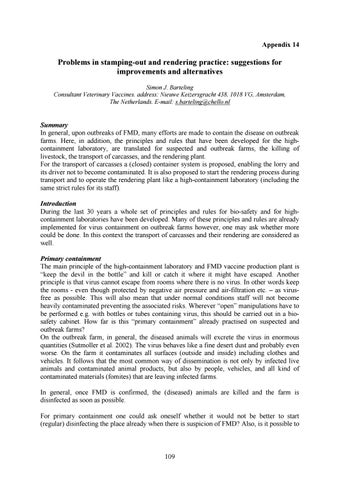Appendix 14
Problems in stamping-out and rendering practice: suggestions for improvements and alternatives Simon J. Barteling Consultant Veterinary Vaccines. address: Nieuwe Keizersgracht 438, 1018 VG, Amsterdam, The Netherlands. E-mail: s.barteling@chello.nl
Summary In general, upon outbreaks of FMD, many efforts are made to contain the disease on outbreak farms. Here, in addition, the principles and rules that have been developed for the highcontainment laboratory, are translated for suspected and outbreak farms, the killing of livestock, the transport of carcasses, and the rendering plant. For the transport of carcasses a (closed) container system is proposed, enabling the lorry and its driver not to become contaminated. It is also proposed to start the rendering process during transport and to operate the rendering plant like a high-containment laboratory (including the same strict rules for its staff). Introduction During the last 30 years a whole set of principles and rules for bio-safety and for highcontainment laboratories have been developed. Many of these principles and rules are already implemented for virus containment on outbreak farms however, one may ask whether more could be done. In this context the transport of carcasses and their rendering are considered as well. Primary containment The main principle of the high-containment laboratory and FMD vaccine production plant is “keep the devil in the bottle” and kill or catch it where it might have escaped. Another principle is that virus cannot escape from rooms where there is no virus. In other words keep the rooms - even though protected by negative air pressure and air-filtration etc. – as virusfree as possible. This will also mean that under normal conditions staff will not become heavily contaminated preventing the associated risks. Wherever “open” manipulations have to be performed e.g. with bottles or tubes containing virus, this should be carried out in a biosafety cabinet. How far is this “primary containment” already practised on suspected and outbreak farms? On the outbreak farm, in general, the diseased animals will excrete the virus in enormous quantities (Sutmoller et al. 2002). The virus behaves like a fine desert dust and probably even worse. On the farm it contaminates all surfaces (outside and inside) including clothes and vehicles. It follows that the most common way of dissemination is not only by infected live animals and contaminated animal products, but also by people, vehicles, and all kind of contaminated materials (fomites) that are leaving infected farms. In general, once FMD is confirmed, the (diseased) animals are killed and the farm is disinfected as soon as possible. For primary containment one could ask oneself whether it would not be better to start (regular) disinfecting the place already when there is suspicion of FMD? Also, is it possible to
109
